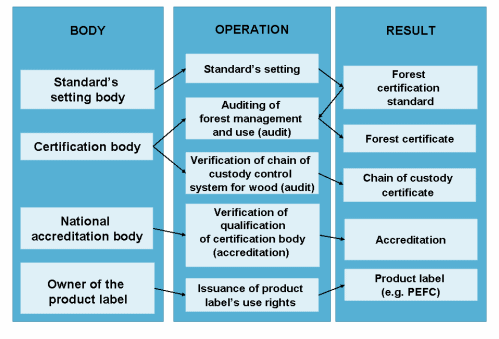
|
Requirements for forest certification are given in standards, which are used as reference documents in certification audits. Audits carried out by certification bodies assess if procedure of forest management conform to the agreed criteria. The criteria for certified forest management can be performance or management system oriented. The performance criteria include e.g., the demand to the protection of key biotopes in harvesting operations. Management system criteria include e.g., elaboration and implementation of various kinds of environmental target programmes or forest management recommendations. Objectives of Forest CertificationThe aim of forest certification is to promote ecologically, economically and socially sustainable forest management. Certification is a market-oriented measure for the promotion of sustainable forest management and responding to the customers' needs. It aims at safeguarding the competitive advantage of wood products on the markets. A label can be used on a product which contain wood fibre from a certified forest. The use of the ecolabel requires a chain of custody verification throughout the different stages of transportation and production. The international requirements set for certification are:
A certification scheme must be acceptable to all the different stakeholders, controlled, and suitable to local conditions. Criteria shall be formulated so that they can reliably measure the level of forest management. The stringency of the criteria must be at a level that promotes the objectives of forest management and certification. One of the most important requirements of certification is reliability. Reliability is based first and foremost on the impartiality of certification bodies and on the general recognition of the standards. A good competence of certification auditors, and a high quality audit are the two main elements of a good assessment. Commitment by different stakeholders to the certification system as well as the publicity of certification standards and procedures contribute to the transparency in certification.
International recognition and credibility is essential to a certification scheme, as it is a precondition for a certificate to have any value in the export markets. International comparability of different certification schemes and their mutual recognition should be promoted. A certification standard should include only those criteria and indicators that are essential for proving the sustainability of forest management. In this way implementation and auditing expenses can remain at a reasonable level. Forest certification is a way to prove that forests are managed in conformance to the agreed criteria set for sustainable forest management. Certification of the chain of custody control system proves that the flow of certified wood fibre can be followed from certified forests to industrial processing plants and threreon to the retail companies. Forest certificate together with the chain of custody management system certificate informs buyers of wood and paper products on the origin of the timber. International forest certification schemes
|
| Copyright © 2005 Suomen Metsäsertifiointi ry - Finnish Forest Certification Council |
